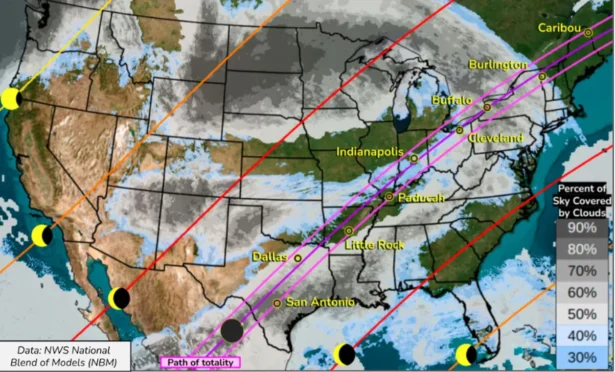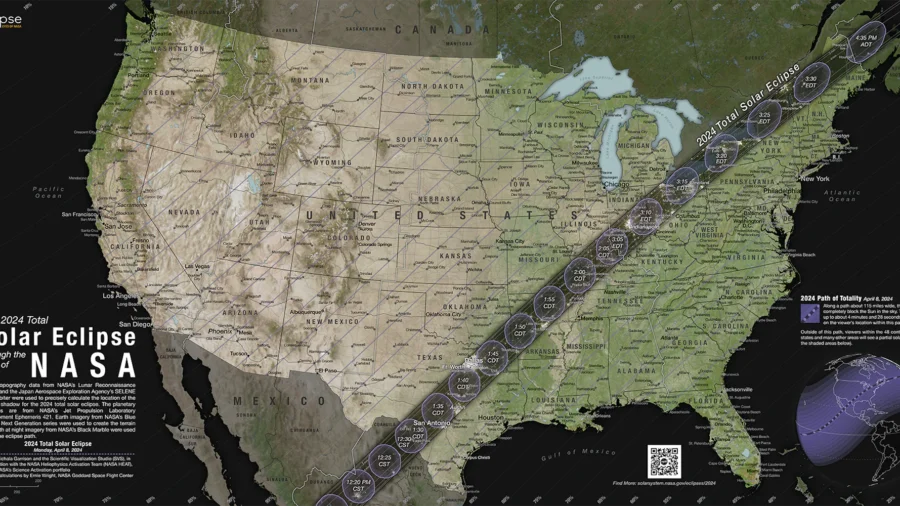The National Weather Service (NWS) issued a forecast for Monday’s solar eclipse, which is slated to pass across much of the United States. However, some key areas will be obscured by clouds or even face “severe” weather.
The agency’s Storm Prediction Center (SPC) has placed nearly the entire eclipse’s path of totality in Texas, Arkansas, and Oklahoma in a “severe” weather risk area for much of Monday. That includes cites such as Austin, San Antonio, and Waco.
Dallas and its surrounding locations were placed on a three out of five on the risk for severe weather due to large hail, according to the agency.
Other Forecasts
The eclipse will carve a diagonal line across North America, going from the south to the northeast, plunging areas in Mexico, the United States, and Canada into several minutes of total darkness.
The weather isn’t looking good for a portion of the eclipse’s path of totality. Clouds could get in the way for a stretch of the route, with the heaviest clouds expected in parts of Texas. There are patches along the way that may be clear for the eclipse, forecasters say.
And meteorologists point out that the eclipse might still be visible if the clouds are high and thin. The one area where clear skies are expected is northern New England through to Canada.
“Monday morning will feature showers and embedded thunderstorms across the Great Lakes down into the Ohio Valley, Tennessee Valley and the lower Mississippi Valley well in advance of the low pressure system and near the trailing cold front. Meanwhile, moisture from the Gulf of Mexico is beginning to return to the western Gulf states,” the NWS’s forecast for Monday says.
In parts of Texas, where the eclipse’s totality path will pass through, they will see “a rapid untimely increase of clouds this morning into the afternoon prior to the arrival of the solar eclipse,” according to the federal agency.
“In contrast,” the NWS added, “northern New England remains to be the region where cloud cover will likely be minimized along the path of totality this afternoon as the nor’easter moves farther out into the Atlantic.”
But NWS forecasters noted: “It appears that other locations in between will have a fair chance of cloud covers at various levels, although locations across Arkansas to the Midwest could see breaks in the clouds or high thin clouds during the time of totality.”
Major U.S. cities like Los Angeles, El Paso, New York City, Boston, and Raleigh should have decent views of the eclipse, he said. Those cities are not located in the eclipse’s path of totality, but practically everyone in North America will have a chance at catching at least a partial eclipse.
The farther from the path of totality, the smaller the moon’s bite will be out of the sun. In Seattle, less than a quarter of the sun will be swallowed. In Miami, it’ll be about half.
“Areas with poor viewing conditions will be from Wisconsin westward through South Dakota and Nebraska to Washington and Oregon,” AccuWeather meteorologist Joe Lundberg noted.
There might be clouds moving across western and central Pennsylvania as well as much of western New York around the time of the eclipse, according to AccuWeather. “There is even a possibility of a passing shower. This could lower viewing opportunity for a couple of hours,” meteorologist Paul Pastelok said on the site.
Here’s a current look of the clouds we’re tracking for today’s total solar eclipse. Mid level clouds extend across eastern Ohio to Pittsburgh and are knocking on the doorstep of Erie. The mid level cloud deck is expected to be over much of the area by early afternoon. #NYwx #PAwx pic.twitter.com/d1O5utvJKr
— NWS Binghamton (@NWSBinghamton) April 8, 2024
“Two areas near the path that are improving are the western Ohio Valley and the lower Great Lakes,” Accuweather meteorologist Brandon Buckingham said. “The best locations for viewing can be the Southwest deserts, much of California, New England and parts of the Southeast,” he added.
Eyesight Warning
Special eclipse glasses are crucial for safely observing the sun. They need to be worn during the partial phases, as the moon covers more and more of our star.
During totality, when the sun is completely shrouded, it’s fine to remove your glasses and look with your naked eyes. But before and after, certified eclipse glasses are essential to avoid eye damage. Just make sure they’re not scratched or torn.
Wherever there’s only a partial eclipse, you need to keep those solar specs on the whole time. Cameras, binoculars, and telescopes must be outfitted with special solar filters for safe viewing.

Staring directly at the sun during a solar eclipse or at any other time can lead to permanent eye damage. Symptoms can include blurred vision and color distortion, health officials have said.
“Remember, totality will only last for a few minutes,” the NWS says on its website. “The sun will still be bright during partial phases of the eclipse. If you are planning on being outside for an extended period of time to watch the entire eclipse, remember to wear sunscreen or protective clothing.”
The Associated Press contributed to this report.
From The Epoch Times


